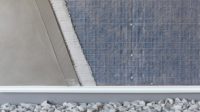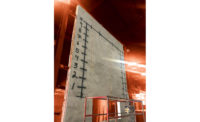Efflorescence is the result of mineral salts deposited on the surface of stucco, EIFS, concrete or masonry. These deposits are typically harmless but can detract from the structure’s aesthetics.
Mineral salts may be found in the materials used in making stucco. Even the water used in mixing these materials may contribute to efflorescence. Typically, the more refined the component, the less likelihood salt will be present. Care must be taken when handling stucco materials on the jobsite to prevent the unintentional addition of mineral salts.
Since soil can contain high levels of salt, stucco sand should be kept off the ground whenever possible. Even a tarp or plastic on the ground can reduce the chance for soil based salts to be introduced to the material. To completely avoid this problem, use a pre-blended stucco product that contains materials that are free of contamination and packaged in such a way as to avoid contact with soil-based salts.
Removal
Efflorescence can be a seasonal problem especially during periods of rain or high humidity when moisture gets re-introduced into the wall and when temperatures begin to rise. The aforementioned salt combines with this moisture and leaches out onto the wall in the form of a white substance.
Stucco surfaces finished with acrylic or elastomeric coatings can help reduce the chances of this occurrence.
Efflorescence is not difficult to remove. Often, efflorescence will diminish during the surface’s life cycle since rain will eventually flush the residual salts from the wall. However, staining can occur in the finish if efflorescence is left for long periods of time. Darker colors tend to show stains more readily than lighter colors and may require painting. Paints or any other coatings should never be applied over efflorescence.
The first option to remove efflorescence is to simply dry brush the area to dislodge the surface deposit. Afterwards, wash the wall thoroughly to remove additional salts that may be present just below the surface. There are chemicals available to help remove tougher buildup. Consult your stucco supplier for recommendations on the best chemicals to use and how they should be applied.
Weather resistance is always a top priority when it comes to building construction in general and window/door frames in particular. One process that helps these products become more resistant to the elements is anodizing.
Anodizing
Anodizing involves placing a sheet of aluminum into a chemical acid bath where quite often acetone is used. The sheet of aluminum becomes the positive anode and the acid bath becomes the negative. An electric current is passed through the acid, causing the surface of the aluminum to oxidize (essentially rust). The oxidized aluminum forms a strong coating as it replaces the original aluminum on the surface and creates an extremely hard substance.
Although anodizing produces a very regular and uniform coating, microscopic fissures in the coating can still lead to corrosion. Further, the coating is susceptible to chemical dissolution when exposed to salts and differing pH levels. Both occur in wet stucco, which is highly alkali and contains alkali salts. These salts react with the aluminum, causing the metal to weaken and lose its resistance to the elements.
Avoid These Issues
Proper masking prior to applying stucco to the wall is recommended. Ensure that the fully exposed surface of the anodized metal is covered with no rips or tears in the tape.
Even proper masking does not make a project immune to damaged anodized aluminum. It is almost a given that some damage will occur and touchup work will be required during or after installation. The good news is that both painted and anodized surface damage can be easily repaired if the damage is slight such as a scratch or rub mark. Sanding anodized material before touch up is not recommended. The anodized surface is aluminum oxide, which is generally harder than the sandpaper. Some rub marks on an anodized surface can be removed with a mild abrasive pad such as the Scotch-Brits pad prior to touch up painting.
Touchup paint is supplied in small aerosols or bottles with a built-in brush for easy application and is to be applied very sparingly. It is intended to cover small blemishes or to touchup exposed cut ends on fabricated parts. It is not intended for use on large areas of more than a few square inches. The color will closely match the factory applied painted or anodized finish, however the finish is not as hard nor does it perform the same as the baked-on finishes. After cleaning the area to be touched up, wipe the area with denatured alcohol to remove any moisture or cleaning residue and apply the touchup per the finisher’s instructions. Use caution as excessive use of touch up paint may void the original finisher’s warranty.
If the damage is unable to be fixed with touch-up paints and sanding, consult the manufacturer for additional suggested methods of fixing.










